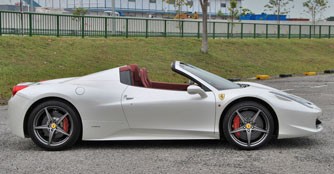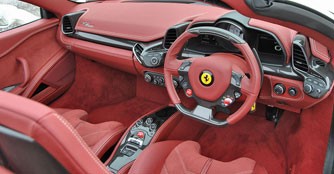Ferrari 458 Spider 4.5 (A) Review
31 Aug 2012|18,102 views
I've always wanted to have a go at the Ferrari 458 Italia ever since it was first announced in 2009. It's not that I've not driven a Prancing Horse previously, but there's just something about the 458 that makes me eager to want to get behind its wheel.
Perhaps it's the way its looks are honed in the wind tunnel for maximum aerodynamic efficiency and downforce or the opportunity to command the 458's 562bhp V8 heart with my right foot that entice me to want to have a go. For three years, I've waited for the opportunity that never came. Then came the local debut of the topless Spider version of the 458, the 458 Spider.
Exterior
On first acquaintance, the Spider looks very much like the familiar coupe thanks to a rather similar roofline and overall silhouette that is the result of the hardtop roof design instead of the traditional canvas top. The use of a retractable aluminium hardtop is a first for a mid-engined sports car - the 458 Spider beating the recently unveiled McLaren MP4-12C Spider to this honour.
In topless Spider form, the 458 is an exceptionally stunning looking car. It retains the superb proportions of the coupe while adding a dose of visual drama with the roof down.
Other distinctive styling features of the Spider include the twin buttresses behind the seats that not only look fantastic but also functions as a roll over bar and to channel air to the engine intakes and coolers. In between the two buttresses is a glass window that can be operated independent of the hardtop roof when required to act as a wind deflector.
Perhaps it's the way its looks are honed in the wind tunnel for maximum aerodynamic efficiency and downforce or the opportunity to command the 458's 562bhp V8 heart with my right foot that entice me to want to have a go. For three years, I've waited for the opportunity that never came. Then came the local debut of the topless Spider version of the 458, the 458 Spider.
Exterior
On first acquaintance, the Spider looks very much like the familiar coupe thanks to a rather similar roofline and overall silhouette that is the result of the hardtop roof design instead of the traditional canvas top. The use of a retractable aluminium hardtop is a first for a mid-engined sports car - the 458 Spider beating the recently unveiled McLaren MP4-12C Spider to this honour.
In topless Spider form, the 458 is an exceptionally stunning looking car. It retains the superb proportions of the coupe while adding a dose of visual drama with the roof down.
Other distinctive styling features of the Spider include the twin buttresses behind the seats that not only look fantastic but also functions as a roll over bar and to channel air to the engine intakes and coolers. In between the two buttresses is a glass window that can be operated independent of the hardtop roof when required to act as a wind deflector.
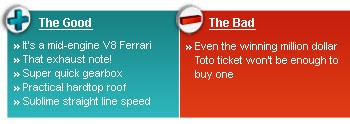 |
The hard top is made up of two sections that fold so as to take up very little space. When the top is retracted, it neatly stows itself away into a compartment ahead of the engine bay in just 14 seconds. The design of the roof though, means that the fire breathing V8 is no longer visible via a glass engine cover like on the coupe.
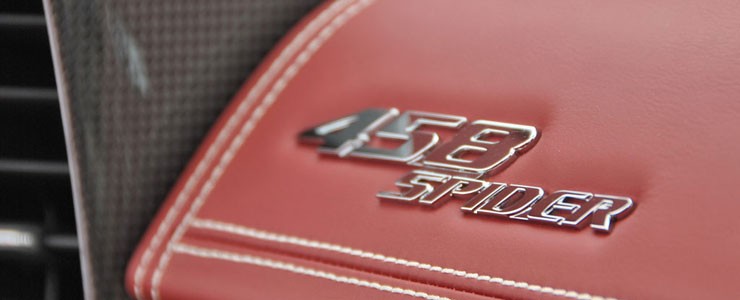 |
The roof also can't be operated while on the move like soft top models can. On the upside, advantages of the hardtop design include a reduction of weight of around 25kg as well as security among others. Furthermore, the exterior can be specified with wheels and calipers that come in different shades while the sills, front spoiler, rear diffuser can be finished in carbon fibre.
Interior
Also benefitting from the space efficient roof design is the useable storage space behind the seats that is big enough to store two pieces of bespoke luggage tailor made for the Spider or a full-sized golf bags according to Ferrari. In addition, the Spider features a 58 litre boot up front that is large enough to store overnight bags for two.
Like the Italia coupe, the Spider's driver-oriented driving environment draws inspiration from the world of Formula 1, with many of its controls placed within the driver's reach on and around the three-spoke steering wheel. The driver is greeted by a unique instrument panel, which consists of a large rev counter flanked by TFT screens on either side. The screens display speedometer readings, parameters for the different manettino modes and so on.
Interior
Also benefitting from the space efficient roof design is the useable storage space behind the seats that is big enough to store two pieces of bespoke luggage tailor made for the Spider or a full-sized golf bags according to Ferrari. In addition, the Spider features a 58 litre boot up front that is large enough to store overnight bags for two.
Like the Italia coupe, the Spider's driver-oriented driving environment draws inspiration from the world of Formula 1, with many of its controls placed within the driver's reach on and around the three-spoke steering wheel. The driver is greeted by a unique instrument panel, which consists of a large rev counter flanked by TFT screens on either side. The screens display speedometer readings, parameters for the different manettino modes and so on.
Just like in the FF, there are no indicator and wiper stalks on the steering column. Instead, these controls (and the horn as well) are integrated onto the steering wheel. The Spider offers several seat options including the carbon fibre racing seats that not only looks good but also offer a nice blend of comfort and support as fitted to the car we tested here. Despite the Spider's low slung looks, the interior offers reasonable amounts of headroom even for the tallest of occupants.
Additionally, just like any high end super car, the 458 Spider can be further customised on the inside by the type of stitching on the seats, the colour scheme and materials on the surfaces.
Additionally, just like any high end super car, the 458 Spider can be further customised on the inside by the type of stitching on the seats, the colour scheme and materials on the surfaces.
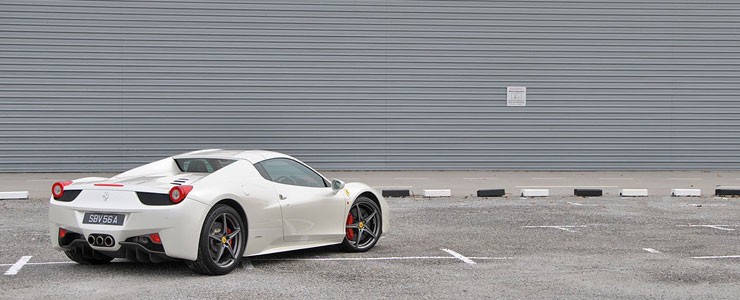 |
The Drive
Lurking underneath the compartment for the retracted roof is the sensational high revving 4499cc V8 from the coupe. Just like the coupe, the 4.5-litre V8 musters 562bhp at a dizzying 9,000rpm and 540Nm of twisting force at 6,000rpm. Despite the high revving nature of the V8, the motor remains tractable and flexible at low engine speeds, pulling strongly from as low as 2,000rpm without any hints of protest. The engine's momentum starts to pick up in the mid-range but it'll deliver its maximum only when past 6,000rpm or at engine speeds that are similar from typical family cars near their redlines.
At this point, the Ferrari V8 takes on a fire breathing character, revving ferociously towards its 9,000rpm, making a huge ruckus along the way as the previously faint exhaust note turns up its volume infinitely. The beauty of the topless Spider is that one can enjoy the exhaust symphony undiluted. Moreover with the Spider, Ferrari says that it has tweaked the V8's exhaust note somewhat so as to maximise the occupants' aural pleasure when the roof is down.
On paper the Spider offers nearly identical performance figures as the marginally lighter coupe - 0 to 100km/h in less than 3.4 seconds, with a top speed quoted at 320km/h. Doing the job of transmitting the V8's tremendous power to the wheels is the familiar F1 twin clutch gearbox as used in the California and FF. With the manettino set in 'Sport' mode, the box shifts incisively and quickly enough. Turn the manettino dial to 'Race' and gear change speed is turned up a notch.
Lurking underneath the compartment for the retracted roof is the sensational high revving 4499cc V8 from the coupe. Just like the coupe, the 4.5-litre V8 musters 562bhp at a dizzying 9,000rpm and 540Nm of twisting force at 6,000rpm. Despite the high revving nature of the V8, the motor remains tractable and flexible at low engine speeds, pulling strongly from as low as 2,000rpm without any hints of protest. The engine's momentum starts to pick up in the mid-range but it'll deliver its maximum only when past 6,000rpm or at engine speeds that are similar from typical family cars near their redlines.
At this point, the Ferrari V8 takes on a fire breathing character, revving ferociously towards its 9,000rpm, making a huge ruckus along the way as the previously faint exhaust note turns up its volume infinitely. The beauty of the topless Spider is that one can enjoy the exhaust symphony undiluted. Moreover with the Spider, Ferrari says that it has tweaked the V8's exhaust note somewhat so as to maximise the occupants' aural pleasure when the roof is down.
On paper the Spider offers nearly identical performance figures as the marginally lighter coupe - 0 to 100km/h in less than 3.4 seconds, with a top speed quoted at 320km/h. Doing the job of transmitting the V8's tremendous power to the wheels is the familiar F1 twin clutch gearbox as used in the California and FF. With the manettino set in 'Sport' mode, the box shifts incisively and quickly enough. Turn the manettino dial to 'Race' and gear change speed is turned up a notch.
The box bangs in the gears nearly instantaneously, almost to the point of being brutal. In manual mode, every pull of the right column mounted paddle equates to an instant reaction from the box's electronics and actuators to call upon the next higher gear. The feeling of the box going up each gear that quickly is just so impressive. On the downshift, the box will automatically blip the throttle as each lower gear is selected.
On the road, the average driver can hardly feel any difference between the fixed roof coupe and the topless Spider here. Thanks to Ferrari's chassis strengthening measures, the Spider doesn't feel any less rigid on the road when compared to the coupe.
Admittedly, an advanced driver might find that the Spider can feel a tad less dynamic than the stiffer coupe, especially on a race track. Ferrari also claims that the Spider is about half a second a lap slower than the coupe on its Fiorano test track, hardly a significant time difference to say the least.
Conclusion
On its own, the Spider is still one dynamic handling super car that can possibly outhandle and outcorner even more expensive models like V12-powered Lamborghinis or even the more powerful, range topping Ferrari models like the 599GTB. The most amazing aspect of the 458's dynamics is its lightning quick responses and the superbly quick and sublime steering.
With the topless Spider, a new dimension is added to the intoxicating 458 driving experience. The Spider's additional weight and slightly less rigid structure hasn't affected the overall 458 on road driving experience at all while it looks better and sounds better from the driver's seat than the coupe.
On the road, the average driver can hardly feel any difference between the fixed roof coupe and the topless Spider here. Thanks to Ferrari's chassis strengthening measures, the Spider doesn't feel any less rigid on the road when compared to the coupe.
Admittedly, an advanced driver might find that the Spider can feel a tad less dynamic than the stiffer coupe, especially on a race track. Ferrari also claims that the Spider is about half a second a lap slower than the coupe on its Fiorano test track, hardly a significant time difference to say the least.
Conclusion
On its own, the Spider is still one dynamic handling super car that can possibly outhandle and outcorner even more expensive models like V12-powered Lamborghinis or even the more powerful, range topping Ferrari models like the 599GTB. The most amazing aspect of the 458's dynamics is its lightning quick responses and the superbly quick and sublime steering.
With the topless Spider, a new dimension is added to the intoxicating 458 driving experience. The Spider's additional weight and slightly less rigid structure hasn't affected the overall 458 on road driving experience at all while it looks better and sounds better from the driver's seat than the coupe.
I've always wanted to have a go at the Ferrari 458 Italia ever since it was first announced in 2009. It's not that I've not driven a Prancing Horse previously, but there's just something about the 458 that makes me eager to want to get behind its wheel.
Perhaps it's the way its looks are honed in the wind tunnel for maximum aerodynamic efficiency and downforce or the opportunity to command the 458's 562bhp V8 heart with my right foot that entice me to want to have a go. For three years, I've waited for the opportunity that never came. Then came the local debut of the topless Spider version of the 458, the 458 Spider.
Exterior
On first acquaintance, the Spider looks very much like the familiar coupe thanks to a rather similar roofline and overall silhouette that is the result of the hardtop roof design instead of the traditional canvas top. The use of a retractable aluminium hardtop is a first for a mid-engined sports car - the 458 Spider beating the recently unveiled McLaren MP4-12C Spider to this honour.
In topless Spider form, the 458 is an exceptionally stunning looking car. It retains the superb proportions of the coupe while adding a dose of visual drama with the roof down.
Other distinctive styling features of the Spider include the twin buttresses behind the seats that not only look fantastic but also functions as a roll over bar and to channel air to the engine intakes and coolers. In between the two buttresses is a glass window that can be operated independent of the hardtop roof when required to act as a wind deflector.
Perhaps it's the way its looks are honed in the wind tunnel for maximum aerodynamic efficiency and downforce or the opportunity to command the 458's 562bhp V8 heart with my right foot that entice me to want to have a go. For three years, I've waited for the opportunity that never came. Then came the local debut of the topless Spider version of the 458, the 458 Spider.
Exterior
On first acquaintance, the Spider looks very much like the familiar coupe thanks to a rather similar roofline and overall silhouette that is the result of the hardtop roof design instead of the traditional canvas top. The use of a retractable aluminium hardtop is a first for a mid-engined sports car - the 458 Spider beating the recently unveiled McLaren MP4-12C Spider to this honour.
In topless Spider form, the 458 is an exceptionally stunning looking car. It retains the superb proportions of the coupe while adding a dose of visual drama with the roof down.
Other distinctive styling features of the Spider include the twin buttresses behind the seats that not only look fantastic but also functions as a roll over bar and to channel air to the engine intakes and coolers. In between the two buttresses is a glass window that can be operated independent of the hardtop roof when required to act as a wind deflector.
The hard top is made up of two sections that fold so as to take up very little space. When the top is retracted, it neatly stows itself away into a compartment ahead of the engine bay in just 14 seconds. The design of the roof though, means that the fire breathing V8 is no longer visible via a glass engine cover like on the coupe.
The roof also can't be operated while on the move like soft top models can. On the upside, advantages of the hardtop design include a reduction of weight of around 25kg as well as security among others. Furthermore, the exterior can be specified with wheels and calipers that come in different shades while the sills, front spoiler, rear diffuser can be finished in carbon fibre.
Interior
Also benefitting from the space efficient roof design is the useable storage space behind the seats that is big enough to store two pieces of bespoke luggage tailor made for the Spider or a full-sized golf bags according to Ferrari. In addition, the Spider features a 58 litre boot up front that is large enough to store overnight bags for two.
Like the Italia coupe, the Spider's driver-oriented driving environment draws inspiration from the world of Formula 1, with many of its controls placed within the driver's reach on and around the three-spoke steering wheel. The driver is greeted by a unique instrument panel, which consists of a large rev counter flanked by TFT screens on either side. The screens display speedometer readings, parameters for the different manettino modes and so on.
Interior
Also benefitting from the space efficient roof design is the useable storage space behind the seats that is big enough to store two pieces of bespoke luggage tailor made for the Spider or a full-sized golf bags according to Ferrari. In addition, the Spider features a 58 litre boot up front that is large enough to store overnight bags for two.
Like the Italia coupe, the Spider's driver-oriented driving environment draws inspiration from the world of Formula 1, with many of its controls placed within the driver's reach on and around the three-spoke steering wheel. The driver is greeted by a unique instrument panel, which consists of a large rev counter flanked by TFT screens on either side. The screens display speedometer readings, parameters for the different manettino modes and so on.
Just like in the FF, there are no indicator and wiper stalks on the steering column. Instead, these controls (and the horn as well) are integrated onto the steering wheel. The Spider offers several seat options including the carbon fibre racing seats that not only looks good but also offer a nice blend of comfort and support as fitted to the car we tested here. Despite the Spider's low slung looks, the interior offers reasonable amounts of headroom even for the tallest of occupants.
Additionally, just like any high end super car, the 458 Spider can be further customised on the inside by the type of stitching on the seats, the colour scheme and materials on the surfaces.
Additionally, just like any high end super car, the 458 Spider can be further customised on the inside by the type of stitching on the seats, the colour scheme and materials on the surfaces.
The Drive
Lurking underneath the compartment for the retracted roof is the sensational high revving 4499cc V8 from the coupe. Just like the coupe, the 4.5-litre V8 musters 562bhp at a dizzying 9,000rpm and 540Nm of twisting force at 6,000rpm. Despite the high revving nature of the V8, the motor remains tractable and flexible at low engine speeds, pulling strongly from as low as 2,000rpm without any hints of protest. The engine's momentum starts to pick up in the mid-range but it'll deliver its maximum only when past 6,000rpm or at engine speeds that are similar from typical family cars near their redlines.
At this point, the Ferrari V8 takes on a fire breathing character, revving ferociously towards its 9,000rpm, making a huge ruckus along the way as the previously faint exhaust note turns up its volume infinitely. The beauty of the topless Spider is that one can enjoy the exhaust symphony undiluted. Moreover with the Spider, Ferrari says that it has tweaked the V8's exhaust note somewhat so as to maximise the occupants' aural pleasure when the roof is down.
On paper the Spider offers nearly identical performance figures as the marginally lighter coupe - 0 to 100km/h in less than 3.4 seconds, with a top speed quoted at 320km/h. Doing the job of transmitting the V8's tremendous power to the wheels is the familiar F1 twin clutch gearbox as used in the California and FF. With the manettino set in 'Sport' mode, the box shifts incisively and quickly enough. Turn the manettino dial to 'Race' and gear change speed is turned up a notch.
Lurking underneath the compartment for the retracted roof is the sensational high revving 4499cc V8 from the coupe. Just like the coupe, the 4.5-litre V8 musters 562bhp at a dizzying 9,000rpm and 540Nm of twisting force at 6,000rpm. Despite the high revving nature of the V8, the motor remains tractable and flexible at low engine speeds, pulling strongly from as low as 2,000rpm without any hints of protest. The engine's momentum starts to pick up in the mid-range but it'll deliver its maximum only when past 6,000rpm or at engine speeds that are similar from typical family cars near their redlines.
At this point, the Ferrari V8 takes on a fire breathing character, revving ferociously towards its 9,000rpm, making a huge ruckus along the way as the previously faint exhaust note turns up its volume infinitely. The beauty of the topless Spider is that one can enjoy the exhaust symphony undiluted. Moreover with the Spider, Ferrari says that it has tweaked the V8's exhaust note somewhat so as to maximise the occupants' aural pleasure when the roof is down.
On paper the Spider offers nearly identical performance figures as the marginally lighter coupe - 0 to 100km/h in less than 3.4 seconds, with a top speed quoted at 320km/h. Doing the job of transmitting the V8's tremendous power to the wheels is the familiar F1 twin clutch gearbox as used in the California and FF. With the manettino set in 'Sport' mode, the box shifts incisively and quickly enough. Turn the manettino dial to 'Race' and gear change speed is turned up a notch.
The box bangs in the gears nearly instantaneously, almost to the point of being brutal. In manual mode, every pull of the right column mounted paddle equates to an instant reaction from the box's electronics and actuators to call upon the next higher gear. The feeling of the box going up each gear that quickly is just so impressive. On the downshift, the box will automatically blip the throttle as each lower gear is selected.
On the road, the average driver can hardly feel any difference between the fixed roof coupe and the topless Spider here. Thanks to Ferrari's chassis strengthening measures, the Spider doesn't feel any less rigid on the road when compared to the coupe.
Admittedly, an advanced driver might find that the Spider can feel a tad less dynamic than the stiffer coupe, especially on a race track. Ferrari also claims that the Spider is about half a second a lap slower than the coupe on its Fiorano test track, hardly a significant time difference to say the least.
Conclusion
On its own, the Spider is still one dynamic handling super car that can possibly outhandle and outcorner even more expensive models like V12-powered Lamborghinis or even the more powerful, range topping Ferrari models like the 599GTB. The most amazing aspect of the 458's dynamics is its lightning quick responses and the superbly quick and sublime steering.
With the topless Spider, a new dimension is added to the intoxicating 458 driving experience. The Spider's additional weight and slightly less rigid structure hasn't affected the overall 458 on road driving experience at all while it looks better and sounds better from the driver's seat than the coupe.
On the road, the average driver can hardly feel any difference between the fixed roof coupe and the topless Spider here. Thanks to Ferrari's chassis strengthening measures, the Spider doesn't feel any less rigid on the road when compared to the coupe.
Admittedly, an advanced driver might find that the Spider can feel a tad less dynamic than the stiffer coupe, especially on a race track. Ferrari also claims that the Spider is about half a second a lap slower than the coupe on its Fiorano test track, hardly a significant time difference to say the least.
Conclusion
On its own, the Spider is still one dynamic handling super car that can possibly outhandle and outcorner even more expensive models like V12-powered Lamborghinis or even the more powerful, range topping Ferrari models like the 599GTB. The most amazing aspect of the 458's dynamics is its lightning quick responses and the superbly quick and sublime steering.
With the topless Spider, a new dimension is added to the intoxicating 458 driving experience. The Spider's additional weight and slightly less rigid structure hasn't affected the overall 458 on road driving experience at all while it looks better and sounds better from the driver's seat than the coupe.
Car Information
Ferrari 458 Spider 4.5 (A)
CAT B|Petrol|8.4km/L
Horsepower
416kW (558 bhp)
Torque
540 Nm
Acceleration
3.4sec (0-100km /hr)
This model is no longer being sold by local distributor
All Used Ferrari 458 SpiderThank You For Your Subscription.





















